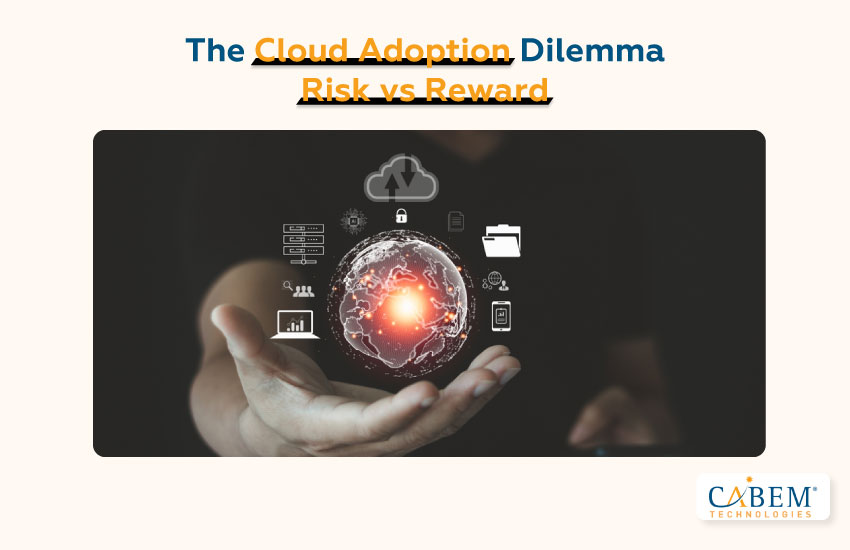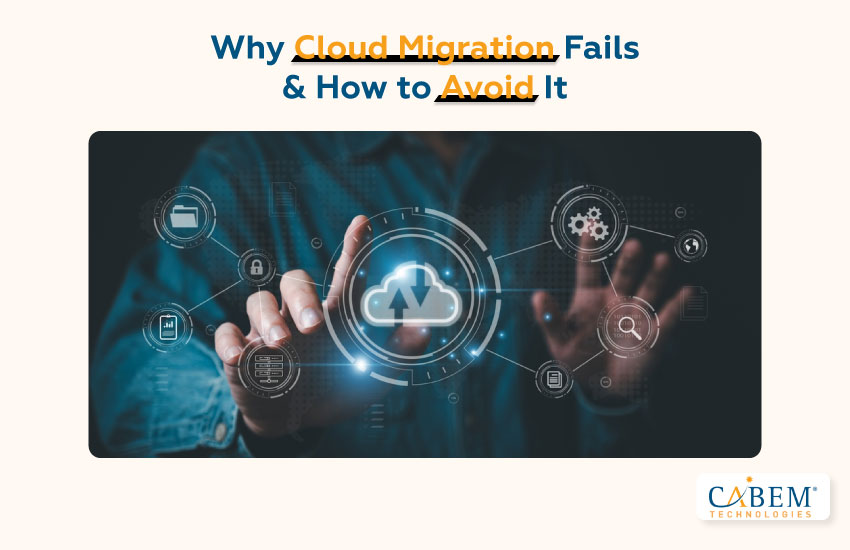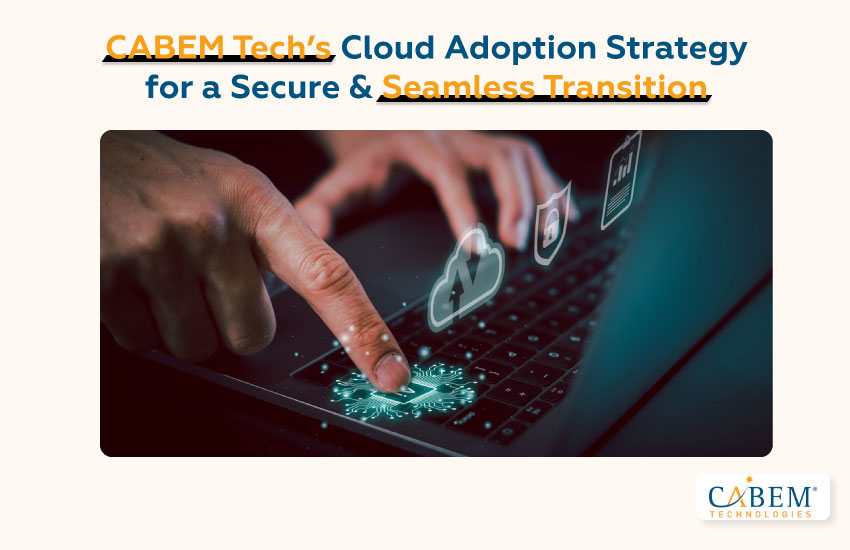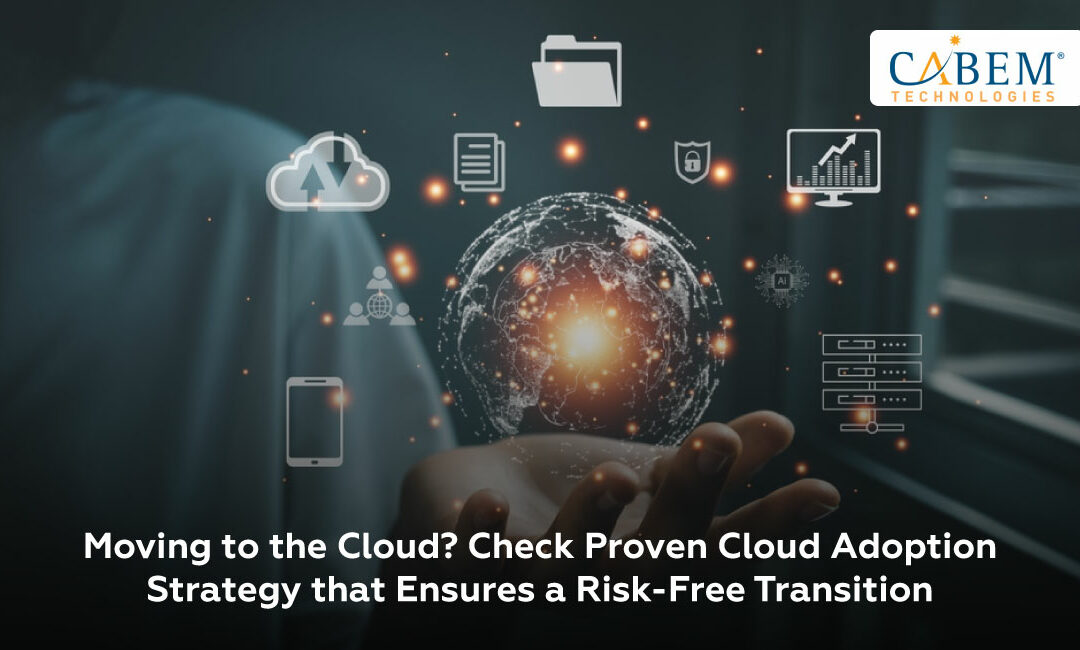Cloud computing is not an abstract future anymore; it is here, and businesses across the globe are migrating their operations to the cloud to leverage its immense potential. However, switching to the cloud is not as easy as flipping a switch. With the wrong approach, businesses may encounter substantial threats in the form of security vulnerabilities, compliance issues, and operational disruptions.
In this article, we’ll explore:
- The Cloud Adoption Dilemma – Risk vs Reward
- Why Cloud Migration Fails & How to Avoid It
- CABEM Tech’s Cloud Adoption Strategy for a Secure & Seamless Transition
- Why Businesses Trust CABEM Technologies for Cloud Adoption
Let’s dive in.

The Cloud Adoption Dilemma – Risk vs Reward
Cloud adoption comes with several risks, which is why tailored planning is critical to maximizing the rewards offered. Many organizations forget about factors that help them become agile and cost-effective, making them prone to failure in the cloud migration process. It is better to understand the causes of failures in cloud migrations beforehand.
Let’s discuss in detail:
Why Businesses are Moving to the Cloud – Cost Savings, Scalability, and Efficiency
The majority of enterprises are effectively cloud based since this approach underpins their business model. Most positive impacts include increased organizational efficiency, cost savings, and speed when setting up new customers and service providers.
- Cost savings: Shifting to cloud allows businesses to leverage the pool of resources, significantly reducing infrastructure and costs as they only incur charges for the resources they consume.
- Scalability: Cloud solutions such as AWS, Google Cloud, and Microsoft Azure allow businesses to scale their resources based on demand, allowing them to adjust quickly and efficiently to changing markets.
- Efficiency: Cloud tools allow teams to collaborate, access resources, and deploy solutions faster than ever with traditional on-premises systems.
The Hidden Risks of Cloud Migration – Security Threats, Compliance Issues, and Operational Disruptions
Though the cloud has numerous benefits, migrating to the cloud can leave some businesses vulnerable to certain risks that should be addressed beforehand.
What if you could transition seamlessly to the cloud—without the risks?
- Security threats: Cloud environments are prime targets for cybercriminals. Poorly configured cloud environments can compromise sensitive data.
- Compliance issues: Compliance with regulatory frameworks such as HIPAA, NIST 800-171, ISO 27001, and CMMC is a significant issue for sectors such as healthcare, finance, and government. Failure to meet these standards can result in hefty fines.
- Operational disruptions: An inefficient cloud migration strategy translates to downtime, affecting productivity and customer experience.
A cloud adoption framework is needed to address unattended security gaps, compliance requirements, transition optimization and facilitate a risk-free migration.

Why Cloud Migration Fails & How to Avoid It
Now you must be well aware of common obstacles that lead to failure in migrating to the cloud, it’s time to focus on thoughtful strategies to mitigate these issues. According to research, 70% of projects that focus on Cloud Migration consistently run into delayed deadlines and cost overruns due to inadequate planning and security gaps. Businesses must develop a comprehensive Cloud Adoption Strategy beyond just addressing the migration. Now, we will delve into how CABEM Technologies adapts and adopts cloud strategies so your business can migrate without worrying about failure.
- Security Vulnerabilities
- Compliance Risks
- Operational Downtime
- Integration Issues
- Hidden Costs
1. Security Vulnerabilities
- According to a study by Gartner, 95% of outstanding cloud security failures are related to misconfiguration of cloud security settings or solid strategic approach in place for security.
- Misconfigured cloud security settings can expose sensitive business information to unauthorized access and lead to costly data breaches.
- According to a 2024 IBM study, the average cost of a data breach worldwide is $4.88 million. Cloud environments are indeed frequent targets due to their vulnerability.
- Case study: Capital One suffered a massive breach in 2019 affecting 106 million individuals due to improper cloud configuration. The breach led to fines as huge as $80 million and even higher remediation costs, indicating a need for stronger security measures during a cloud migration.
2. Compliance Risks
- Moving to cloud-based services without system alignment to regulations such as HIPAA, ISO 27001, GDPR, and NIST 800-171 raises the possibility of exposure to legal penalties and reputational damage.
- The fines imposed under GDPR have exceeded 1 billion euros, so companies must ensure compliance when migrating sensitive data to the cloud.
- According to a PwC survey from 2024, 60% of businesses reported risks of non-compliance in their use of cloud services, which was particularly pronounced in sectors handling sensitive data.
- Failure to comply can result in fines, operational restrictions, and loss of customer trust.
3. Operational Downtime
- Migrations to the cloud can also incur operational downtime and inhibit productivity and revenue intake. McKinsey & Company states that poorly managed cloud transitions can cause a 20-30% decrease in productivity for companies.
- In 2017, GitLab suffered a five-day outage as it went through the cloud migration process. In this case, the company faced user trust issues, which resulted in a loss of user trust and delayed service delivery.
- Careful preparation and management are necessary to avoid lengthy downtimes and facilitate a smooth transfer with well-defined contingency plans.
4. Integration Issues
- Migrating on-premise legacy systems to the cloud presents integration challenges. According to a recent survey by Deloitte, 40% of companies still cannot integrate their on-premise systems with their cloud systems.
- Integration issues leave operational workflows disjointed and create data silos that further obstruct the operational efficiency and effectiveness of the migration strategy.
- In 2017, General Electric (GE) struggled to integrate its legacy systems into the cloud, delaying deployment and using extra resources.
- Properly integrating legacy systems with cloud platforms is critical for a seamless transition.
5. Hidden Costs
- Unexpected costs associated with migrating to the cloud are a major consideration. According to a 2021 Gartner report, 55% of enterprises overrun their cloud budgets by nearly 24% on average due to unexpected costs such as data transfer, storage fees, and licensing costs.
- One example is Snap Inc. (parent company of Snapchat) in 2019. It reported a $50 million run-over cost in cloud expenses after scaling its cloud infrastructure without implementing a proper cost-control strategy.
- To avoid hidden costs, businesses must track cloud expenses, implement cost management tools, and optimize cloud resources carefully to prevent budget overruns.
How to Avoid Cloud Migration Failures
Now that we have pinpointed the most common challenges for businesses, let’s talk about how to tackle these issues effectively and undergo a successful cloud migration:
- Set Clear Expectations and Plan Ahead
- Prioritize Security and Compliance
- Invest in Training and Skill Development
- Implement Effective Cost Management Tools
- Ensure Seamless Integration
1. Set Clear Expectations and Plan Ahead
- Before migrating to the cloud, businesses must thoroughly understand the requirements for each workload, including performance, security, and compliance.
- Good planning will help set realistic expectations for the organization and ensure each cloud solution meets its goals. This will allow the organization to mitigate the risk of surprises during the migration process.
2. Prioritize Security and Compliance
- During the cloud migration, security and compliance are the areas that must take precedence. It means using encryption, multi-factor authentication, and frequent security audits to safeguard sensitive data.
- To comply with regulatory standards, organizations should identify certifications such as ISO 27001 or NIST 800-171 that can guide compliance with cloud migrations.
3. Invest in Training and Skill Development
- Ensuring that IT teams are adept at using cloud management and security solutions is essential to a successful cloud migration strategy.
- Training internal teams lowers the likelihood of operational lapses during migration, ultimately improving efficiency.
- To facilitate the migration, a firm may engage the services of a specialist who will manage the migration process
4. Implement Effective Cost Management Tools
- Businesses should implement content management systems, such as AWS Cost Explorer, Azure Cost Management, or Google Cloud’s Billing and Cost Management tools, to address hidden costs.
- By regularly monitoring and optimizing cloud spending, businesses can prevent extra charges and stick to budgets during the migration process.
5. Ensure Seamless Integration
- Businesses need to facilitate the integration of their legacy systems with cloud solutions earlier in the migration process. A good integration plan will guarantee that everything interacts well and has minimal impact.
- Businesses may also need to re-architect legacy systems to ensure all systems are compatible with cloud services.

CABEM Tech’s Cloud Adoption Strategy for a Secure & Seamless Transition
CABEM Technologies recognizes the complexity of cloud adoption and has developed an effective model to aid in mitigation.
Here is the way we advise clients on cloud adoption:
- Cloud Readiness Assessment – Know Before You Migrate
- Security & Compliance-First Cloud Transition
- Seamless Migration with Zero Downtime
- Custom Cloud Integrations for a Unified IT Ecosystem
- Ongoing Optimization & Cost Management
1. Cloud Readiness Assessment – Know Before You Migrate
Before leaping, assessing your business’s cloud readiness is crucial. This involves:
- Examining your existing infrastructure to evaluate which workloads are most appropriate for transitioning to the cloud.
- Recognizing potential obstacles like security, compliance, or integration problems that may affect the migration process.
Our cloud readiness assessment equips you with the information to understand your organization’s weaknesses and strengths, which in turn helps you plan properly and avoid many of the common issues that badly affect the businesses.
2. Security & Compliance-First Cloud Transition
Overcoming security and compliance concerns is paramount when moving to the cloud. CABEM Tech’s cloud adoption approach drives you that:
- Security is built into your cloud environment with strong access controls, encryption, and protocols.
- Your cloud migration process complies with industry regulations like HIPAA, ISO 27001, and NIST 800-171.
Compliance is a never-ending process, however, we collaborate with businesses to ensure compliance is not compromised in the transition to the cloud, helping to avoid expensive penalties and reputational damage.
3. Seamless Migration with Zero Downtime
Any downtime during the migration to the cloud can often lead to lost productivity and customer frustration. Therefore, we achieve this zero-downtime with our approach by:
- Verify and validate the cloud infrastructure during migration.
- Providing a smooth migration process with minimal disruption to your operations, ensuring continuity and customer satisfaction.
We believe in a seamless migration that prioritizes business continuity.
4. Custom Cloud Integrations for a Unified IT Ecosystem
Your current operational platforms may not integrate seamlessly with the cloud. CABEM specializes in custom cloud integrations such as:
- Linking traditional systems with cloud-based tools.
- We provide for a smooth transition of your applications and workflows into the cloud.
All business operations will be integrated through our services for better data flow and inter-system communication.
5. Ongoing Optimization & Cost Management
Transitioning to the cloud is not an endpoint but a starting point. After migration, we continue optimizing your cloud environment:
- Cost management: We can help businesses reduce costs by optimizing cloud spending and identifying inefficient spending.
- Performance monitoring: Regular monitoring keeps your cloud environment running smoothly and aligned with your business requirements and goals.
This ongoing assistance guarantees that you do not simply “exist in the cloud” but are actively succeeding in the cloud.

Why Businesses Trust CABEM Tech for Cloud Adoption
At CABEM Technologies, we have more than 21 years of experience successfully assisting many businesses in moving to the cloud. We have built trust with our clients by providing:
- Deliver customized strategies for cloud adoption that fit particular business outcomes.
- Maintain security and compliance in highly controlled industries.
- Zero-downtime migrations for business continuity.
Selecting CABEM Tech means choosing an integrated partner who will guide you through your secure, cost-efficient, and scalable cloud journey.
Note: Do you want more information to protect your business in the cloud? Read our latest blog post Cloud & Cybersecurity 101: Standards, Frameworks, and Certifications to find out how your organization can protect your data and ensure you meet industry standards.

Schedule a Call with CABEM Tech & Future-Proof Your Business with a Secure Cloud Transition Today!
Transitioning to the cloud is one of your business’s most important steps, but it isn’t the easiest. A new report from McKinsey shows that 60% of companies struggle with cloud migration, facing unexpected costs, integration failures, and security vulnerabilities. Fortunately, the right Cloud Adoption Strategy can clear these challenges, enabling a seamless transition and a future-ready infrastructure.
At CABEM Technologies, we develop bespoke cloud-adoption frameworks that streamline and secure the migration process. We appreciate that every business is different, so we consider your needs at every step—from pre-migration assessments to post-migration optimization. Having served businesses for over 21 years and delivered custom solutions to many, including large regulated enterprises, we facilitate seamless transition to the cloud without downtime or data loss.
Are you ready to future-proof your business and embrace the cloud? Give us a call today and let us help you with a secure and optimized cloud migration at a low cost! Our goal is to replace the cloud environment with a long-term solution that evolves with your business needs instead of treating it as a short-term fix. Start building your future in the cloud today.
Contact us today to arrange a call with one of our cloud specialists and start planning your successful and secure cloud migration!
FAQs
What is the cloud adoption strategy?
A cloud adoption strategy determines how you move your workloads to the cloud. This strategy may involve security, compliance, cost management, and choosing the right cloud platform for your business.
What would be considered a cloud migration risk when moving to the cloud?
Risks associated with cloud migration may involve security vulnerabilities, regulatory non-compliance, operational downtime, data loss, and high, unexpected costs.
What is the problem with cloud migration?
Unexpected charges related to cloud migrations are a common problem. However, other factors, such as insufficient planning, a lack of relevant expertise, and compliance issues, can also create problems.
What is the biggest challenge in cloud migration?
The most complicated aspect of cloud migration is executing it without business interruptions. This includes minimizing downtime, protecting sensitive data, and integrating legacy systems.

